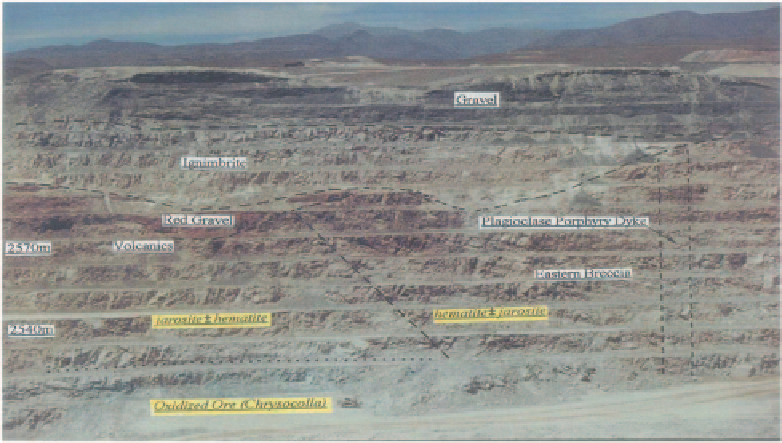Geoscience Reference
In-Depth Information
Fig. 14.3
Photograph show-
ing some of the rock types and
oxide mineralization, along with
contacts and some local faulting.
Benches are 10 m high
Figure
14.3
shows a picture of the upper section of the open
pit wall, with elevations, main lithology zones, mineralization
types (LIX and OX), and some structural features annotated.
values, while Figs.
14.5
and
14.6
show the distribution of
TCu grades in oxide and supergene sulfide mineralization,
respectively. Note that the overall average of the TCu val-
ues in the database is 0.62 % TCu; the overall average of the
oxide grades is 0.88 % TCu and represent about 30 % of the
total dataset; for sulfide samples, the average is even higher
(1.20 % TCu), representing about 21 % of the total number of
samples. Other sulfide mineralization, such as hypogene (or
primary) mineralization, has much lower grade (0.33 % TCu,
almost 15 % of the database). At Cerro Colorado, primary
mineralization has no economic significance, since the op-
eration only processes leachable mineralization, i.e., oxides
and supergene sulfides.
Tables
14.1
,
14.2
and
14.3
show the basic statistics
for TCu samples by lithology, mineralization type, and
alteration, respectively. Finally, Table
14.4
shows the basic
statistics for SCu according to mineralization type.
The following conclusions can be drawn from the tables
above:
• There are 1,991 samples without TCu values and with-
out mineralization type; there are also 311 samples that
have no lithology, and 2,571 samples for which there is
no alteration available.
• Most of the TCu grade exists in porphyry, andesites, and
breccias. There is very little mineralization in gravels,
ignimbrites, and dikes.
• The Leach mineralization type is essentially barren, with
an average TCu grade of 0.1 %, although there are iso-
lated high values, up to 3.74 % TCu. These high grades
are attributed to oxide mineralization that cannot be
recovered in the mine's SX-EW plant, generally called
“black” oxides, and include minerals such as cuprite,
native Cu, and Cu Wad.
• The overwhelming majority of samples present phyllic
alteration. There will be limited use for alteration as a
mineralization control.
14.1.5
Structural Geology
Cepeda et al. (
1982
) identified numerous, northwest-trend-
ing, post-mineral faults in surface mapping and exploration
adits and cross TCus. These generally strike N60 to 70W
and dip vertical to 70 ° east. No orebody displacement is ap-
parent. The northeast elongation of the East deposit suggests
that northeast-trending pre-mineral faults may have been
present. Abrupt contacts between leach, oxide and sulfide
bodies also suggest that northwest-trending faults or fracture
zones may have influenced the development of these units.
14.1.6
Database
The database includes a mixture of older holes used for the
original feasibility study and later in-fill and short-term drill
holes, intended to support detailed Mine Planning. Blast hole
data were used in a limited fashion for calibration and recon-
ciliation of the resource model to past production. Through
statistical analyses, the different data types and sources were
shown to be consistent.
The database contains 1,575 drill holes, including Reverse
Circulation (RC) and Diamond Drill Hole (DDH) types.
Sampled intervals are generally 2 m, except in overburden,
where no sample is taken. The sample's lithology, alteration,
and mineralization type is logged from the samples. Total Cu
(TCu) and Soluble Cu (SCu) are assayed. Some older holes
do not have geologic information.
There are a total of 56,018 sample intervals with TCu
grade. Figure
14.4
shows the histogram of the TCu sample

